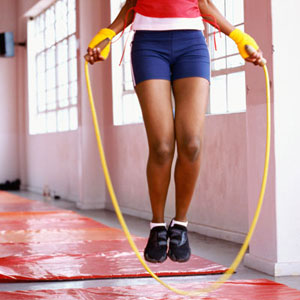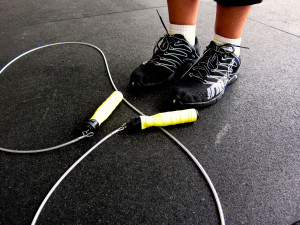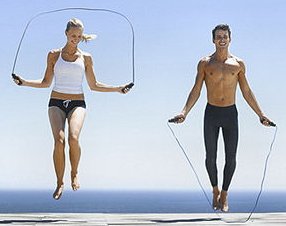Rope jumping or skipping is an excellent way to keep fit. It can be done anywhere and at any time.Skipping is no longer confined to the school playground. Boxers use skipping as training before a fight and it is now incorporated into many gym classes. Skipping proves to be a great workout and is completely cardio driven, too with little outlay financially.
Weighted jump ropes are also available for athletes to increase the difficulty and effectiveness of the exercise. Individuals or groups can participate in the exercise, and learning proper jump rope technique is relatively simple compared to many other athletic activities. The exercise is also appropriate for a wide range of ages and fitness levels.
GETTING STARTED
- Wear the right kit
You should swap your running shoes for some cross trainers, basketball shoes or tennis shoes, because they are able to provide more tailored support for your feet.
- Check the length of your rope
Make sure it’s right for your height by standing in the middle and lifting up the handles. They should reach just below your shoulders. You can shorten most skipping ropes by tying the string shorter.
Remember, skipping is a strenuous exercise so start slowly. Try skipping for 20-30 seconds, marching on the spot for 30 seconds, repeat. As your fitness improves you can increase the time you skip for. Once you have perfected the basic move, you can make your workout more interesting by trying some of the following jumps:
- Skipping on the spot – Keeping your back and head straight, gently jump from one foot to the other, allowing the rope to pass under your feet, and shifting your weight from one foot to the other as you skip.
- Bell jumps – Jump backwards then forwards as you skip, working the fronts of your thighs. Aim for a steady pace – about 70 skips a minute.
- Running-step skips – Pull your knees up in front of you in a running motion as you skip. This will engage your lower abs. Pick up your speed to about 80 skips a minute.
- Straddles – Skip once with your feet together, then jump with your legs out to either side and skip once. Alternate for the full interval. This move works both your inner and outer thighs.
- Skip Jump – Hop on one foot and kick the other foot to the front (or behind) the body, alternate legs
- Hop Jump – hop on one leg for several jumps, alternate legs (start with 2 per leg and increase as you improve)
BURN RATE
Depending on your weight and exertion level you’ll burn between 70-110 extra calories* in a ten minute session.
10min Skipping:
Moderate, 70kcal
Vigorous, 110kcal
TIPS
- Don’t forget to stretch before you start and after you finish.
- Skipping may not be suitable for everyone. As a high-impact activity avoid it if you have joint problems.
- Warm up and cool down by marching on the spot for 3-5 min, and stretching your calves.
- When skipping aim to keep your elbows tucked into your sides, with the rope turning around smoothly in your wrists.
- A common mistake is to lean forward, or skip too slowly. Both of these result in the rope being caught by your feet.
BENEFITS
1. One hour of rope skipping will burn up to 1,300 calories.
2. According to the British Rope Skipping Association, 10 minutes of skipping can have the same health benefits as a 45-minute run.
3. You get a beautiful skin. Rope jumping helps to reduce acne in the following ways:
- It increase blood flow, which means more nutrients get to your skin
- Promotes elimination of toxins
- Strengthens internal organs to work more efficiently
- Can open pores and eliminate toxins through sweat
- Heavily contributes to hormonal balance
- Relieves tension and stress
4. You get a healthy Lymphatic System. The lymphatic system is like your body’s sewer system. It removes all sorts of waste and toxins from the blood and moves them out to be eliminated. However, unlike the circulatory system, the lymphatic system doesn’t have a pump. It relies on the expansion and contraction of the muscles to move it around your body. And rope jumping assists in moving the lymphatic system.
5. It is a full body workout. Jumping rope literally has it all – it works your legs, it works your abs, it works your arms, it works your heart, it works your mind. It increases strength, agility, speed, timing and rhythm. Its medium impact increases bone density, but isn’t as hard on your joints as running. It’s both a fantastic cardio and strength training workout all in one.
6. You can do it anywhere. You’ll need a four-by-six-foot area, and about 10 inches of space above your head. The exercise surface is very important. You’ll need to find a springy surface to perform this workout, so avoid concrete and tiles. Do not attempt to jump on carpet either. While carpet reduces impact, the downside is it grabs your shoes and can twist your ankle or knee. Use a wood floor, piece of plywood, or an impact mat made for exercise. It may seem like one needs a lot of space to jump rope, but it doesn’t.
7. Equipment is minimal and easily transported. All these benefits, and you don’t even need any fancy machines, heavy weights, or complicated equipment. A jump rope is simple, put in your backpack or even your purse, and you can take it anywhere with you.
8. It is Inexpensive. Once you’ve bought your rope, skipping is a zero-cost workout. It’s cheap and totally worth it. One can purchase it from any departmental store or a sports shop.
9. A regular skipping session improves muscle tone in both the lower and upper body.
10. A great fat-buster. Skipping can help you shed up to 450 calories in just 30 minutes. One of the most important ways that jumping rope can be used is as a means to achieve weight loss. Jumping rope for 30 minutes will produce a caloric burn of approximately 300 calories–and therefore, in order to lose one pound per week, you must jump rope for thirty minutes every day and cut out 400 calories from your diet. While this may seem intimidating, it will promote the greatest amount of weight loss in the healthiest manner possible.
11. It promotes cardio-vascular fitness. Each session leads to better cardio-respiratory improvements, making the heart stronger and allowing it to pump more blood, delivering oxygen and nutrients to your tissues. Your cardiovascular system involves your heart and the arteries and veins that bring blood and oxygen to and from the heart and the rest of the body. Therefore, by improving the ability of this system to work, you will not only have a greater ability to perform your daily tasks, but you will become less breathless during exercise as well.
12. Fights osteoporosis. Since skipping is weight bearing, it boosts a person’s bone density, helping to keep off osteoporosis. The Osteoporosis Society recommends two to five minutes of a physical activity like skipping every day to help prevent osteoporosis.
13. Jump rope is a great way to improve the muscle tone in your legs and lower body. After the first day of jumping rope, one may experience some soreness in your legs. The reason for this soreness is because the muscles have been working hard enough to cause micro tears. These micro tears will eventually heal themselves in a few days and because of this damage and repair, your muscles will be stronger, larger, and more toned than when you started the exercise.
14. Increases focus and concentration power. It also improves coordination, balance and flexibility.
15. There are tons of tricks to keep it interesting. After you’re an expert at jumping rope, it may become repetitive but luckily there’s all sorts of variations you can do with the jump rope to keep things interesting. Tricks and variations include the basic one hop, alternating jumps, one foot jumps, side straddles, front straddles, running in place, double under, and the arms cross! Some of them are already discussed.
16. It is complete fun. Do your rope jumping exercise with music. Jump along to your favourite song. Just a tip – EDMs and Dubstep give back better results.
If this post motivated you enough, then what are you waiting for? Grab a rope and just skip!




Leave a Reply